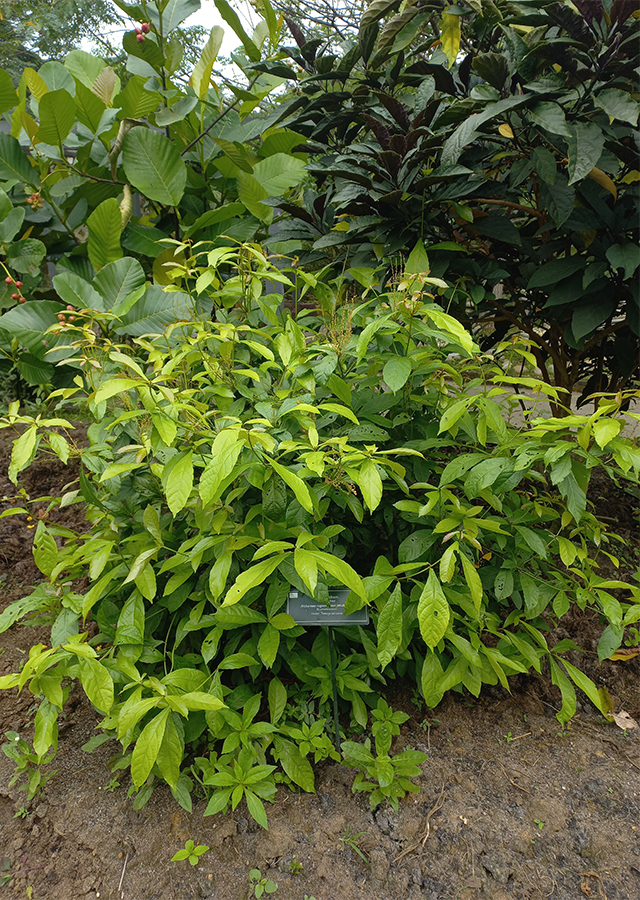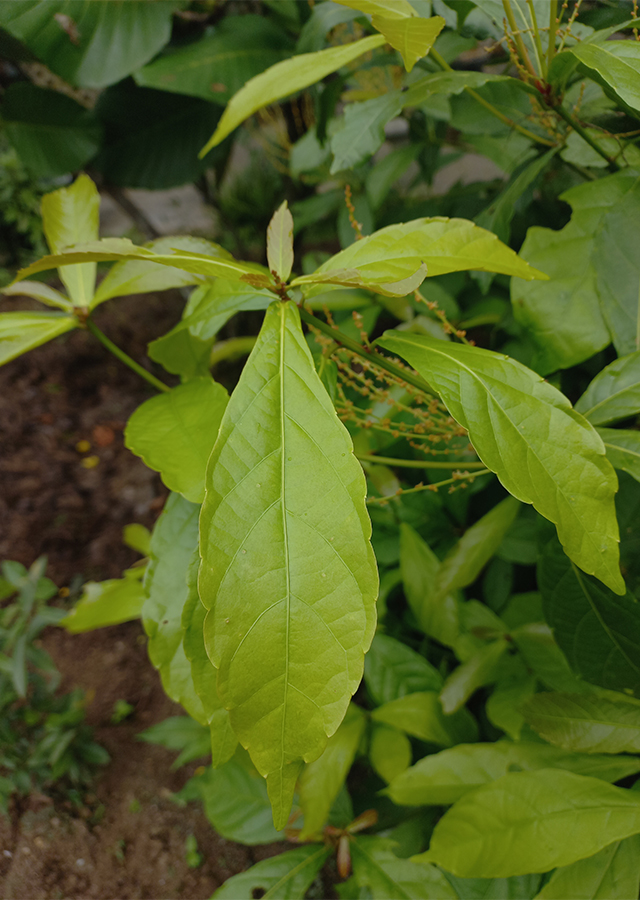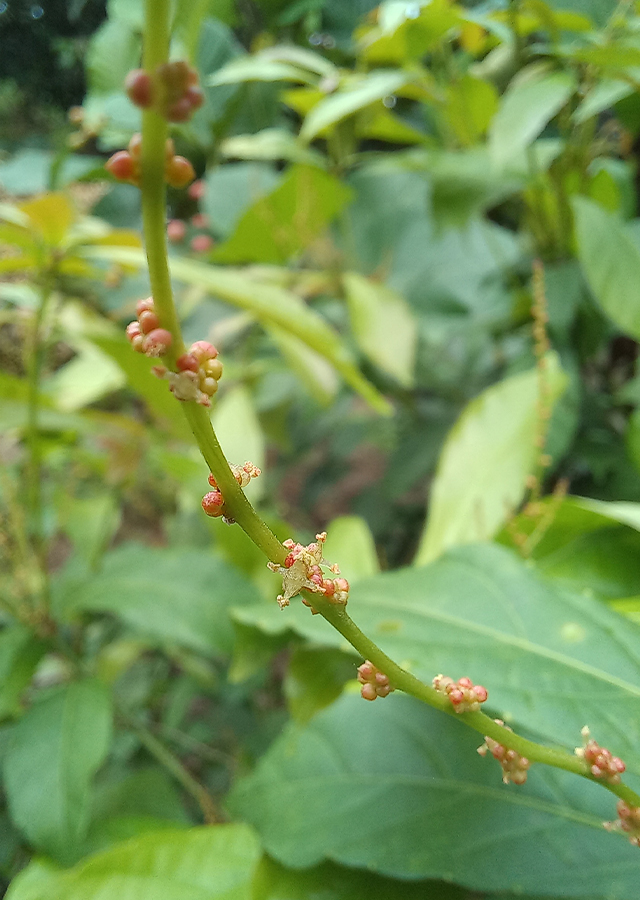Alchorn Tree
Alchornea rugosa (Lour.) Müll.Arg.
Euphorbiaceae
Location in our garden
Principal



Synonym
Cladodes rugosa Lour.
Alchornea javanensis (Blume) Müll.Arg.
Alchornea javanensis (Blume) Backer & Bakh.f.
Habitus
Shrubs. Shrubs or small trees, dioecious, growing up to 10 m tall.
Part Used
Leaves
Seeds
Fruit
Roots
Stem
Growing Requirements
Need Shade
Habitat
Forest
Grassland
Terrestrial
Overview
Alchornea rugosa is native to East Asia - China, Assam, Myanmar, Thailand, Vietnam, Malaysia, Indonesia, Philippines to New Guinea, northern Australia and the Bismarck Islands. The tree is sometimes harvested from the wild as a local source of food and medicines. The leaves are cooked and eaten as a vegetable, and the wood is used for fuel.
Vernacular Names
Julong jantan (Malaysia), Aguioi (Tagalog-Philippines), Thaangpoi (Thai), Yu mai shan ma gan (Chinese), Dom d[os]m (Vietnamese).
Agroecology
A plant of the moist tropics, where it is usually found at elevations up to 1,200 m, occasionally ascending to 2,800 m. Its habibat is in shady or semi-shady places in various primary forest types; secondary and very degraded seasonal forests; grass fields, cultivated places; coconut plantations etc; often in wet places like marshes or along water courses. Found on a wide range of soils in the wild, often on or near limestone, partly even on guano near caves, clay loam, deep clay, ultramafic; bedrock: shale, quartzite, sandstone, granite.
Morphology
- Stem - branchlets pubescent when young, becoming glabrous. The bole is up to 15 cm in diameter.
- Leaves - stipules subulate, 5-7 mm; petiole 0.5-3 cm; leaf blade cuneate-obovate or elliptic to broadly lanceolate, 10-21 × 4-10 cm, margins serrulate, apex acuminate; venation pinnate, lateral veins 8-12 pairs.
- Flowers - inflorescence terminal, branched, 7-25 cm, puberulent or glabrous; bracts triangular. Male flowers 5-11 per bract,sepals 2-4, stamens 4-8. Female flowers: pedicel ca. 1 mm, pubescent; sepals 5, triangular, pubescent; ovary densely puberulent; styles 3, filiform. 3.5-7 mm.
- Fruits - pedicel ca. 2 mm; capsule 3-lobed, ca. 8 mm in diameter, subglabrous.
- Seeds - ovoid, ca. 5 mm, brownish, verrucate.
Cultivation
It is generatively propagated by seeds.
Chemical Constituents
Five compounds: 3β-friedelanol, friedelan-3-one, methyl syringate, isovite- xin, and rhoifolin.
Traditional Medicinal Uses
- A decoction of leaves and roots has been used in Malaysia to treat fever and ague.
- In Indonesia and Vietnam, the fruits have been applied as a purgative.
- The leaf juice is used in Papua New Guinea as an abortifacient.
Part Used
Reference Sources
- Australian Tropical Rainforest Plants. (2020). Alchornea rugosa (Lour.) Mull.Arg. https://apps.lucidcentral.org/rainforest/text/entities/alchornea_rugosa.htm. 18-02-2024.
- Fern, Ken. (2023). Tropical Plants Database: Alchornea rugosa. https://tropical.theferns.info/viewtropical.php?id=Alchornea+rugosa. 18-02-2024.
- Flora of China. (No date). Alchornea rugosa (Loureiro) Müller Argoviensis. http://www.efloras.org/florataxon.aspx?flora_id=2&taxon_id=242302060. 18-02-2024.
- Lemmens, R.H.M.J. and N. Bunyapraphatsara (Editors). (2003). MEDICINAL AND POISONOUS PLANTS. Backhuys Publishers, Leiden (pg.57). Also available: https://edepot.wur.nl/411238. 18-02-2024.
- Pham Van Huyen, Nguyen Thi Thu Hien, Nguyen Huu Huong Duyen, Nguyen Thi Dieu Thuan. 2022. Chemical constituents from the leaves of Achornea rugosa (Lour.) Müll. Arg.(Euphorbiaceae). Vietnam Journal of Science and Technology 60(3):343–349. DOI:10.15625/2525-2518/15442. Chemical constituents from the leaves of Achornea rugosa (Lour.) Müll. Arg.(Euphorbiaceae) | Request PDF (researchgate.net). 18-02-2024.
- PROSEA. (2016). Alchornea rugosa (PROSEA). Alchornea rugosa (PROSEA) - PlantUse English (plantnet-project.org).18-02-2024.4.
- Royal Botanic Gardens, Kew. (2023). Plants of the World Online: Alchornea rugosa (Lour.) Müll. Arg. https://powo.science.kew.org/taxon/urn:lsid:ipni.org:names:338454-1. 18-02-2024.
- Thi-Phuong Doan, Eun-Jin Park, Byeol Ryu, Hyo-Moon Cho, Sang-Jun Yoon, Gwan-Young Jung, Phuong-Thien Thuong, Won-Keun Oh. 2023. Unique guanidine-conjugated catechins from the leaves of Alchornea rugosa and their autophagy modulating activity. Phytochemistry. Volume 206, February 2023, 113521. Unique guanidine-conjugated catechins from the leaves of Alchornea rugosa and their autophagy modulating activity - ScienceDirect. 18-02-2024.


